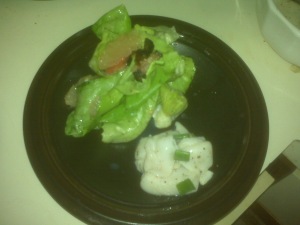There is a very short list of culinary things more satisfying than duck confit. And when I say very short list, I mean I can’t think of anything but I am allowing for the possibility. It is “low and slow” at its finest and the kind of dish that people believe to be far more difficult than it actually is. Sadly, most grocery stores no longer carry duck on a regular basis (and almost never carry just the legs) so you need to contact you local butcher or specialty shop. If you live in the DC area, Wagshall’s is the best around.
Duck Confit
4 duck legs including the thighs (skin off is optional but so much better – reserve the skin to make duck cracklings*)
8 medium shallots
16 cloves of garlic
4 cups of duck fat
Kosher Salt – yes I am being very specific because large grain sea salt will not work properly; kosher salt has the perfect texture.
Freshly Cracked Pepper
Two strips of thick cut bacon
Lay your duck legs on a large slice of aluminum foil and coat each side liberally with Kosher Salt and Freshly Cracked Pepper**. Slice two shallots on your mandoline (seriously, you don’t have one of those yet?) and separate the rings by hand placing them on each side of the duck legs. Smash and dice six cloves of garlic. Sprinkle the legs with on all sides with the garlic bits. Arrange the duck legs as closely as they’ll go and wrap the foil around them as tightly as possible. Refrigerate for at least 24hours but preferably 36.
When ready to cook, melt the duck fat in a sauce pan over a low flame – if you cannot find duck fat, you can use a vegetable oil. The purists might protest this substitution, but I have made it both ways at the same time for a taste test. While the duck fat is better, the oil confit is pretty damn tasty too.
Slice and separate the remaining shallots on the mandoline and set aside. Smash – but do not dice – the remaining cloves of garlic, and set aside.
Remove the duck legs from the refrigerator and brush off the salt and pepper. A bit of it will still stick to the meat and that is as intended. Arrange the duck legs closely together, but not touching, in a Pyrex pan.
Pour the melted fat over the duck which must be fully covered for proper cooking. If using oil rather than fat, heat the oil over a low flame until warm but well below the flash point. If you have a candy/fry thermometer, use it to get the oil to about 200 degrees.
In one corner of the pan, add the smashed garlic; place the shallots in the opposite corner. Think little piles of each. They are intended to flavor the fat/oil and become a dish unto themselves.
Cut the bacon strips in half and place the four pieces them in the fat/oil. Put the dish in an oven that has been pre-heated to 225 degrees. Cook for three hours.
Using a slotted spoon remove the garlic and drain any excess. Remove the shallots and drain excess. The garlic and shallot confits can be used as a garnish, refrigerated for another time, or my favorite use, spread on toasted baguettes and served as a canapé. Yes this part is optional but you might as well.
Remove the duck and let it drain/cool just bit before serving. By the by, this is nearly impossible to over cook which is among the reasons it works so well as a main course for a dinner party. You should also save the old fat/oil because it can be reused many times over.
I love serving this with Potatoes Escoffier, or the Truffled French Fries from this dish.
* a recipe for another day
** this is a really good reason to have a spice mill or coffee grinder dedicated exclusively to grinding pepper.
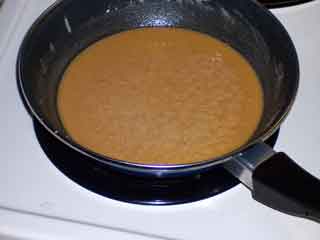 This picture* is pretty close to the color you want. It will take about 30-45 minutes to achieve this color.
This picture* is pretty close to the color you want. It will take about 30-45 minutes to achieve this color.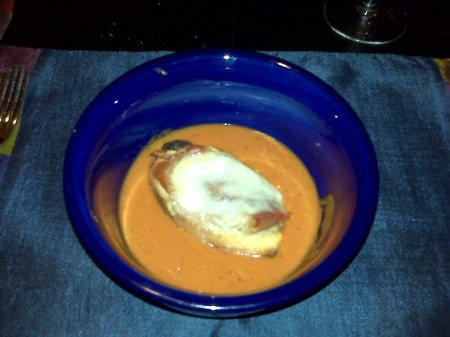 Serve with the Crostini on the side of the bowl or directly in the soup as I did and enjoy.
Serve with the Crostini on the side of the bowl or directly in the soup as I did and enjoy.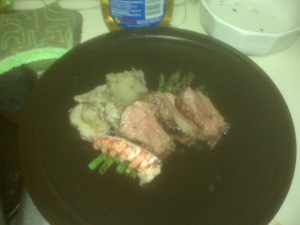
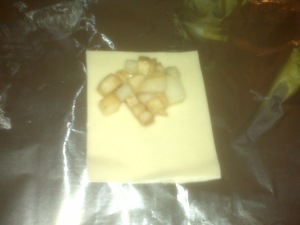 Once the fruit mixture has cooled to room temperature or thereabouts, beat the egg in a bowl. Using two spoons, fill each wonton and seal with the egg wash. Using the back of a fork to further seal them isn’t a bad idea either. Sprinkle them with a sugar and let them sit at least thirty minutes at room temperature. If making dumplings well in advance of frying them, refrigerate them after the initial thirty minutes room temperature period. Remove them from the refrigerator at least twenty minutes before frying.
Once the fruit mixture has cooled to room temperature or thereabouts, beat the egg in a bowl. Using two spoons, fill each wonton and seal with the egg wash. Using the back of a fork to further seal them isn’t a bad idea either. Sprinkle them with a sugar and let them sit at least thirty minutes at room temperature. If making dumplings well in advance of frying them, refrigerate them after the initial thirty minutes room temperature period. Remove them from the refrigerator at least twenty minutes before frying.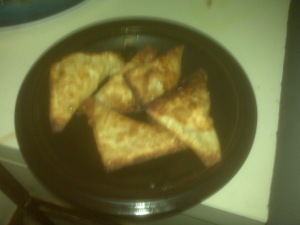
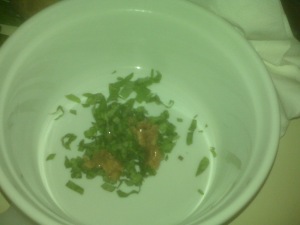 or other implement and add to the oil. Roll the basil leaves into a finger and slice into ½ inch strips and add to the oil. Add the oregano and a sprinkle of salt to the oil. Let it cook for about 30 minutes while the meat comes to room temperature. Failing to cook meat at room temperature is among the most frequent mistake people make with food.
or other implement and add to the oil. Roll the basil leaves into a finger and slice into ½ inch strips and add to the oil. Add the oregano and a sprinkle of salt to the oil. Let it cook for about 30 minutes while the meat comes to room temperature. Failing to cook meat at room temperature is among the most frequent mistake people make with food.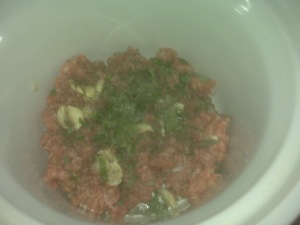 to use a wooden spoon to separate the meat but wait just a minute until everything has come back to temperature. Stir the meat around until it has the ground meat texture. It will take about an hour to mostly brown and cook.
to use a wooden spoon to separate the meat but wait just a minute until everything has come back to temperature. Stir the meat around until it has the ground meat texture. It will take about an hour to mostly brown and cook.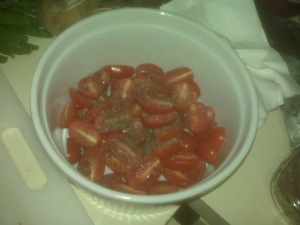 Halve the grape tomatoes and place in a salad bowl. Roll several fresh basil leaves into a cylinder about the size of your pinkie finger and slice into thin strips; add to the bowl. Dice the spring onions and add to the bowl.
Halve the grape tomatoes and place in a salad bowl. Roll several fresh basil leaves into a cylinder about the size of your pinkie finger and slice into thin strips; add to the bowl. Dice the spring onions and add to the bowl.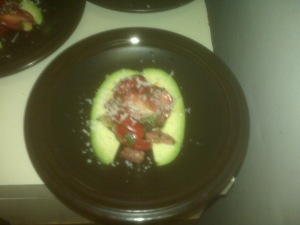 The result is an exercise in creamy, salty, chewy, acidic and fatty balance. I decided to grate some parmesan atop before serving, but upon tasting it, I don’t think it adds enough to merit inclusion.
The result is an exercise in creamy, salty, chewy, acidic and fatty balance. I decided to grate some parmesan atop before serving, but upon tasting it, I don’t think it adds enough to merit inclusion.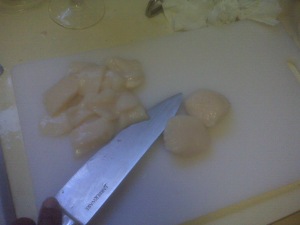 Slice the scallops into 1/8th inch thick strips and place in a bowl. Juice lemons over the scallops until it is well covered. Add a teaspoon of salt and a teaspoon of pepper to the scallops and stir until well mixed. Let stand for sixty minutes. The acid from the limes and the lemons will cook the scallops.
Slice the scallops into 1/8th inch thick strips and place in a bowl. Juice lemons over the scallops until it is well covered. Add a teaspoon of salt and a teaspoon of pepper to the scallops and stir until well mixed. Let stand for sixty minutes. The acid from the limes and the lemons will cook the scallops.